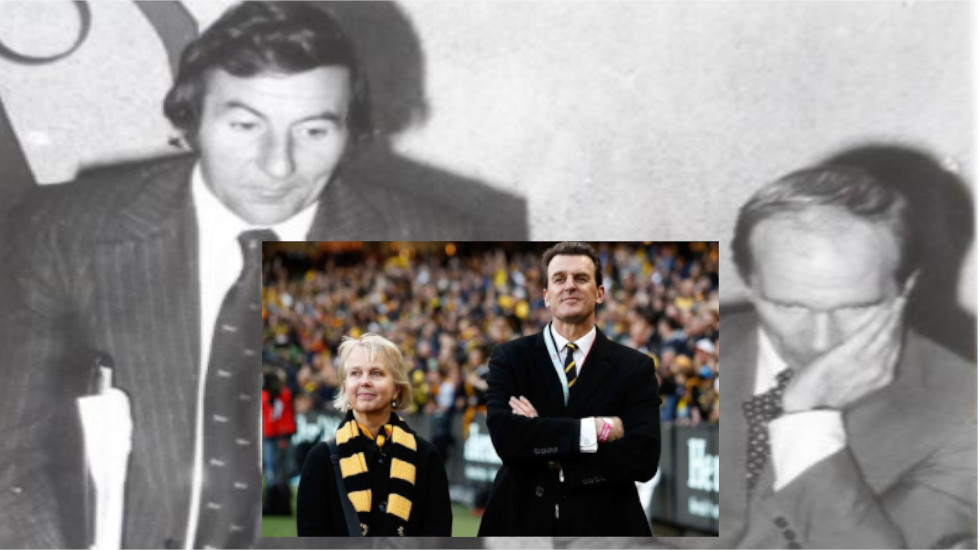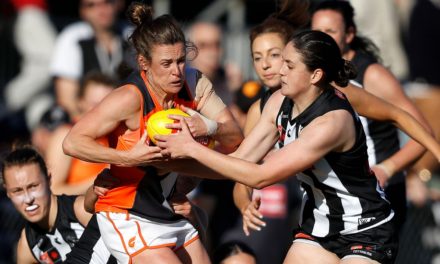Former Richmond president Ian Wilson (left) and powerbroker Graeme Richmond. (Inset): Peggy O’Neal and Brendon Gale
“Never blame the son for the sins of the father.” – Traditional proverb
Oh, for an unexpurgated account of the bodies buried and skeletons rattling around at Tigerland!
Extra-marital affairs, training punch-ups, paper bags stuffed with cash, lawsuits, walkouts, officials threatening violence against other officials, broken promises by the gallon and money, so much money, squandered because of the egos of men living in the past.
Given the backstory, current chief executive Brendon Gale and president Peggy O’Neal have walked a tightrope, beautifully it must be said, between acknowledging a debt to the club’s glory days and burnishing any methodology or messaging that harks back to those very same days.
In steering this course, Gale and O’Neal have been so very wise. Theirs is a salutary lesson in modern AFL management and one that the likes of Essendon should envy.
Indeed, the fallout and ongoing recriminations from the Bombers’ failure to win a final since 2004 are resembling the barren decades that followed Richmond’s disastrous summer of 1982 and its subsequent trade war with Collingwood.
As the story is oft told, after the Magpies poached Geoff Raines and David Cloke – who were ripe for the plucking – the Tigers embarked on a fruitless, profligate trade war that sent the joint bankrupt.
It was the previously untouchable duo of powerbroker Graeme Richmond and president Ian Wilson who were pulling the strings back then, thumbing their noses at the league and scouring the land for players to fill positions that were already filled, just to keep the pressure tap on.
Behind the scenes, according to then general manager Kevin Dixon, “GR” was strong-arming the club to recruit players who, in more sober-minded times, would never have been considered.
Intent on revenge, hundreds of thousands of dollars in transfer fees were spent on the likes of Phillip Walsh, Peter McCormack, Terry Wallace, Daryl Sutton, Craig Stewart, Gary Frangalas and Jeff Dunne. Legal bills racked up between Richmond and Collingwood alone came to an estimated $1.5 million.
This “Eat ‘em Alive” mentality was undoubtedly a weapon in the golden era, but with the VFL itself in financial strife, players asserting their rights, transfer fees going through the roof and court battles becoming commonplace, the Tigers were left hopelessly exposed.
Unsurprisingly, the money ran out. By the end of 1984, Wilson was forced to appeal to the VFL for funds to pay staff salaries.
Six years later, those still stumbling around the place, plus wide-eyed newcomers, were rattling jars up and down Swan Street as part of the “Save Our Skins” campaign, a now-celebrated effort to stave off a debt of $1.7 million – a sum less than Fitzroy owed, but sizeable enough for the club’s outstanding creditor, the ANZ, to threaten foreclosure.
Because of reckless spending and hubris, Richmond was arguably the least-prepared club – even more poorly resourced than Fitzroy – at the outset of the national competition. It took a quarter of a century to catch up.
The architects of the madness, Wilson and “GR”, had by then buggered off. But according to Kevin Bartlett, coach from 1988-91, even in the throes of the cancer that would kill him, “GR” was lighting fuses, just as he had undermined Tom Hafey a decade-and-a-half earlier.
Wilson, for his part, throws up his hands when asked about what went wrong. To invoke part of the American vernacular, he continues to “plead the Fifth”.
But the rot that came after, the shocking performances, board upheavals, recruiting embarrassments and debt piled upon debt, should never be forgotten.
The two highest scores Richmond had conceded since its admittance to the VFL competition in 1908 occurred within 21 months.
PLEASE HELP US CONTINUE TO THRIVE BY BECOMING AN OFFICIAL FOOTYOLOGY PATRON. JUST CLICK THIS LINK.
In Round 18, 1987, the Sydney Swans piled on 198 points, and in Round 9, 1989, Geelong went one step further, topping the double ton at the MCG on the way to a 134-point hiding.
The best player this columnist has ever seen, and its most troubled, Gary Ablett senior, finished with 14 goals. The entire Richmond team managed 10.
By that stage, favourite son Bartlett was in charge. “KB” was no master of the collective goal in his playing days, but he was on a hiding to nothing as coach.
The club was fund-less and friendless, its premiership heroes – Michael Roach, Jim Jess, Mark Lee – playing injured or disenchanted, and the logistical and financial realities of the new national competition accelerating Richmond’s decline.
The upshot of it all was a basket case off the field and a laughing stock on it. Between 1985 and 1993, Richmond won 57 games from 198 starts.
A flicker of promise with a new generation of youngsters in the 1990s – Matthew Richardson, Matthew Knights, Brendon Gale and co. – was extinguished with yet another coaching turnover, the ineptitude exemplified by the Punt Road carpark tangle between then-coach John Northey and roped-in committeeman Mal Brown.
Another flicker in the early 2000s under Danny Frawley, a figure the playing group felt sorry for, turned to dust as the club overreached, frittered away draft picks and brought in older, last legs campaigners. Come in Justin Blumfield, Adam Houlihan and Paul Hudson, if you please.
When Frawley was mercifully let go, it represented Richmond’s 11th coaching change since Kevin Sheedy was appointed at Windy Hill for the 1981 season. What an indictment.
After a typically ugly board stoush in 2004 and a last-placed finish, divisions were rife on and off the field. Clinton Casey handed over the presidency reins to Gary March a year later and the club was again seriously broke; March was left to deal with a debt estimated at $6 million.
More miseries followed. Another wooden spoon. Thrashings. Does anyone remember being at Docklands in 2007 as Geelong destroyed the Tigers by 157 points? I do – the scoreline read 20 goals to two at half-time.
By 2011, the debt still stood at $6 million. Once again, without a hint of irony or shame, the Tiger hierarchy went back to the well, with yet another appeal for Richmond supporters to prop up the place.
“We want to be arrogant and the envy of all clubs,” said March at the launch event for the “Fighting Tiger Fund”. “I want to be disliked. I want to be loathed.”
And prop it up they did, with millions of dollars flooding in via a mix of events, appeals and corporate, public and member donations.
This time around, thankfully, the money wasn’t squandered. Rather, it went towards financing the redevelopment of facilities at Punt Road Oval and eradicating the debt.
Funds were also injected into total player payments and the football department, which had suffered from poor resourcing since the 1980s, was significantly bolstered. List management, finally, became a science. The rest is history.
As the man who recruited O’Neal to the board, hired Gale as CEO and appointed Damien Hardwick as coach, Tiger fans owe March a great deal.
Tellingly and wisely, however, those who have subsequently overseen Richmond’s stunning recent success have shied away from the language that March used.
It harks back to another era, an era which the celebrated became the condemned.











